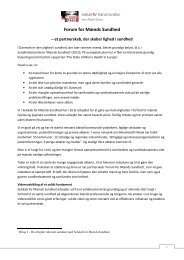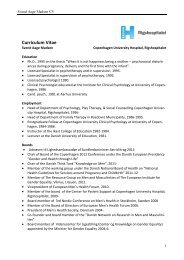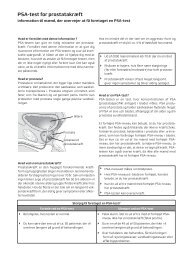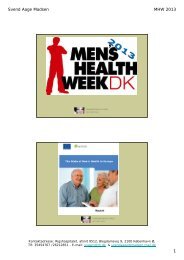Untitled
Untitled
Untitled
You also want an ePaper? Increase the reach of your titles
YUMPU automatically turns print PDFs into web optimized ePapers that Google loves.
Accidents, Injuries and<br />
Violence<br />
Main points<br />
• Throughout the EU, there is a clear and consistent pattern of higher<br />
mortality rates among males compared to females from accident and<br />
violence-related injuries.<br />
• There are considerable differences between countries with male mortality<br />
rates from accident and violence related injuries being particularly high in<br />
Eastern Europe.<br />
• Accidents account for the biggest proportion of deaths within this<br />
classification group (some 36,000 male deaths in EU27) with death rates<br />
from road traffic accidents being 3 times higher in males than in females.<br />
Men account for 95 % of fatal workplace accidents.<br />
• Homicide accounts for 5,500 deaths annually in the EU27 with the rate of<br />
homicide being twice as high for males as for females.<br />
• Road injuries are the principal cause of accidental fatality.<br />
• The economic costs associated with accidents in the EU are estimated at<br />
over € 15 billion a year.<br />
• Whilst the vast majority of both victims and perpetrators of violence are<br />
male, females are much more likely to be victims of intimate partner<br />
violence (IPV).<br />
Summary<br />
Men’s accidents, injuries and violence are a major public health problem within<br />
the EU. Male risk taking, the effect of male anti-social behaviour, male work<br />
and play activities and the management of mental and emotional conflict are<br />
all implicated in the higher rates seen in men. With the exception of sexual<br />
violence (for which 90 % of victims are women) 72 % of interpersonal violence<br />
victims and perpetrators are men. Homicide accounting for over 5,500 deaths<br />
each year also rises exponentially in young males after the age of 15 and peaks<br />
again in the 80 plus age group.<br />
In light of the large intercountry variations in mortality rates from injury, it<br />
seems prudent that policy lessons and tried and tested preventive programmes<br />
established in low mortality countries could be used as a blueprint for good<br />
practice initiatives for countries with higher injury mortality rates. If all countries<br />
matched those with the lowest mortality rates, half of the lives lost to road<br />
traffic injuries and 9 out of 10 of those lost to drowning, poisoning, burns and<br />
falls could be saved each year. With men being vastly overrepresented in the<br />
17








